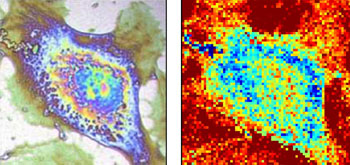Thermal Microscopy Could Help Detect Disease
By LabMedica International staff writers
Posted on 10 Jan 2016
A thermal microscope that produces heat maps of single cells could help detect disease conditions at the sub-cell scale, according to a new study. Posted on 10 Jan 2016
Researchers at the University of Bordeaux (France) developed a label-free, non-ionizing technique based on a thermal lens (TL) to capture images of single cells with a ∼2 μm resolution. Instead of monitoring the TL effect in the cell itself, which has a low photothermal coefficient, they used a thin titanium film that acted as a high-resolution thermoelastic lens. They then used it to investigate thermorheological behavior of cells, with acoustic imaging via an inverted pulsed optoacoustic microscope (iPOM) used to support the effusivity obtained from the thermal images.

Image: Classical phase contrast image (L) of a cell compared to thermal imaging (R) (Photo courtesy of the University of Bordeaux).
Since the temperature variations involved are small and occur on a micron-sized spot, the researchers could not rely on a standard thermometer. Instead, the used a laser to measure the titanium sheet's deformation upon heating. When the temperature is high—i.e., without a cell on the other side—the metal sheet dilates locally. When the temperature decreases, as when a cell is probed, the sheet's profile returns to normal. The comparison between the thermal and acoustic images revealed a simultaneous increase in the sound velocity and the effusivity. The study describing the technique was published in on December 29, 2015, in Applied Physics Letters.
“We flash heat the titanium sheet by only a few degrees with a micrometric laser spot; you might say we 'heat the spot' to image the temperature variations on the bottom side of the sheet. If there is no cell on the other side, the heat remains in the titanium sheet and the temperature increases,” said Thomas Dehoux, a researcher at the University of Bordeaux National Centre for Scientific Research (CNRS). “Conversely, if there is a cell on the other side it will absorb heat and create a cold spot on the sheet. Each part of the cell absorbs heat differently, thanks to the inhomogeneities in its thermal properties. This allows us to see through the metal sheet and produce a thermal image of the cell.”
Cell activity influences the thermal properties of cells, which in turn regulates their ability to store, transport, or exchange heat with their environment. At the tissue level, this explains why infected wounds feel warm to the touch. Cancer cells, in particular, contain a thermal signature that reflects a higher metabolism than those of healthy cells. This feature is useful for grading tumors and can be used to complement classical histological analysis.
Related Links:
University of Bordeaux









 Analyzer.jpg)




